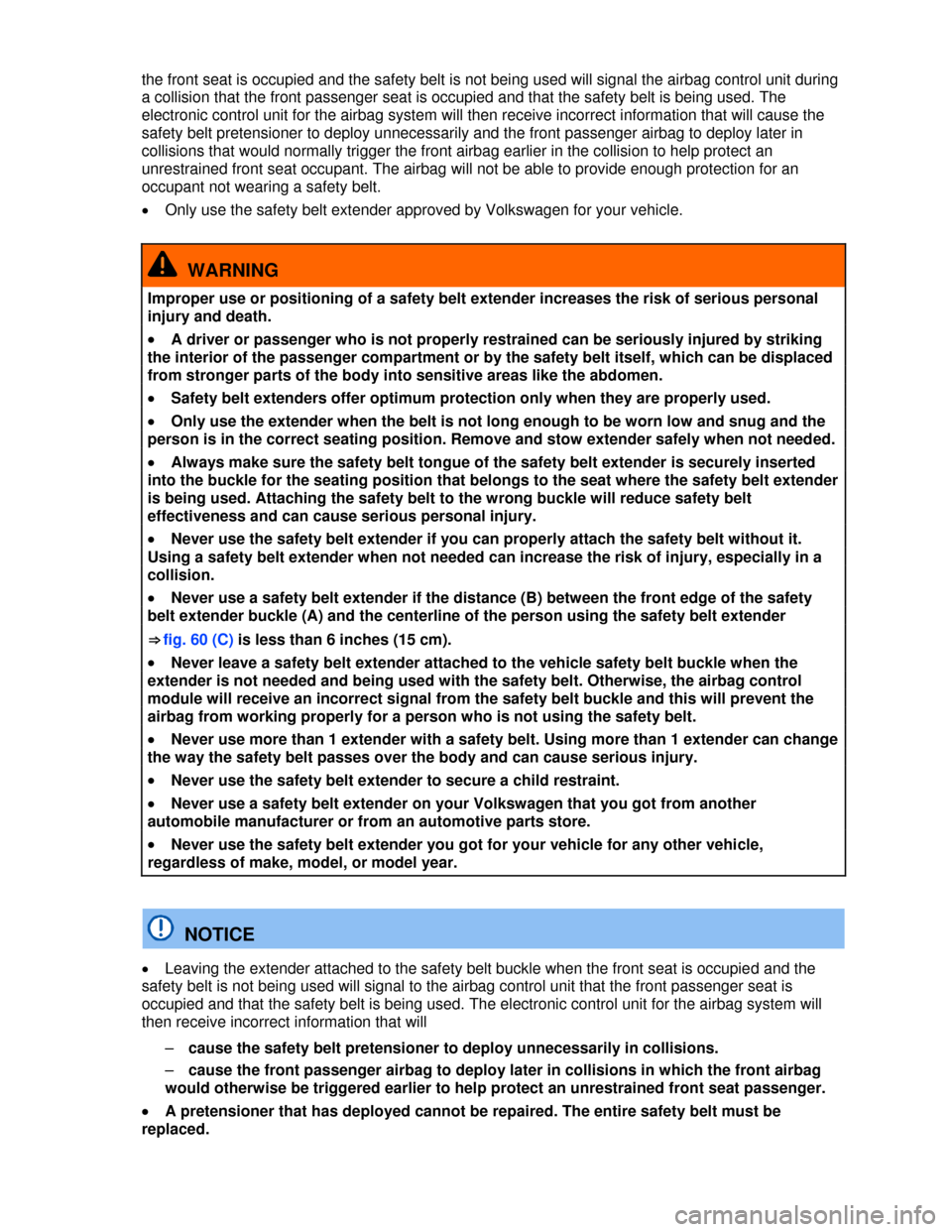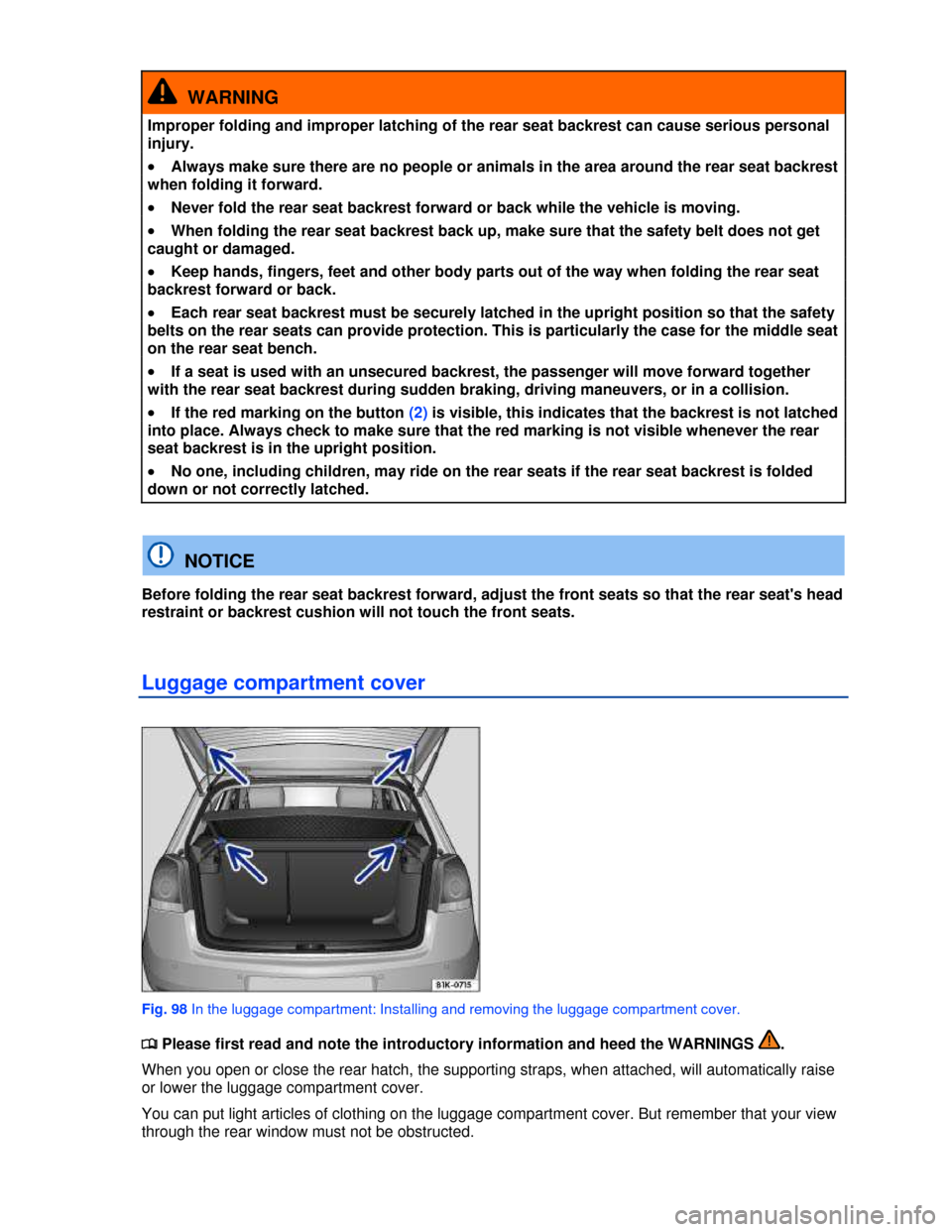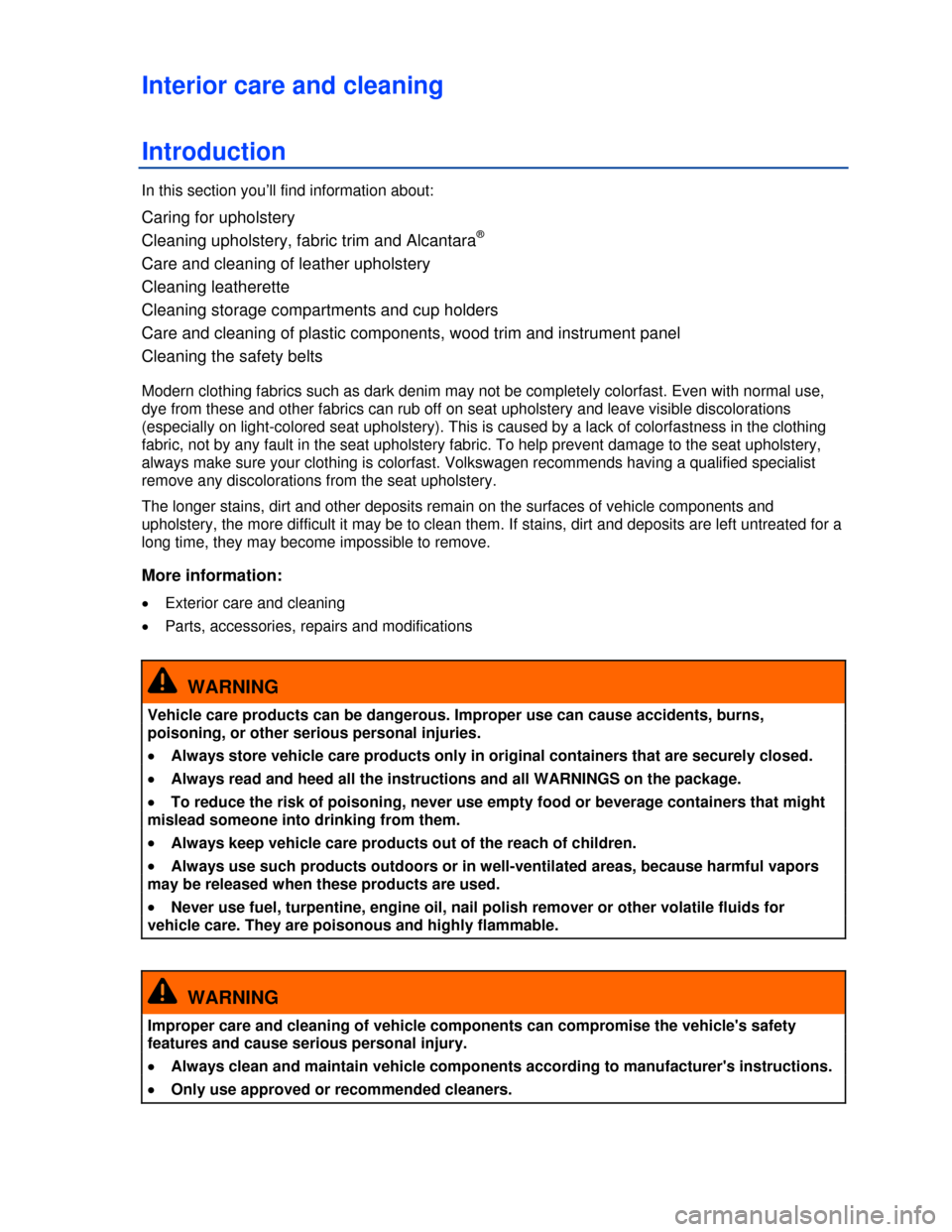2013 VOLKSWAGEN GOLF GTI child seat
[x] Cancel search: child seatPage 74 of 319

Safety belts
Introduction
In this section you’ll find information about:
Warning light
Warning light
Frontal collisions and laws of physics
What happens to passengers not wearing a safety belt
Safety belts protect
Using safety belts
Fastening and unfastening safety belts
Safety belt position
Safety belt height adjusters
Safety belt extender
Safety belt retractor, pretensioner, load limiter
Service and disposal of belt pretensioners
Properly worn safety belts are the single most effective means of reducing the risk of serious injury
and death in a collision or other accident.
Damage to safety belts reduces their overall effectiveness and increases the risk of serious personal
injury and death whenever the vehicle is being used.
Check the condition of all safety belts regularly.
If a safety belt shows damage to webbing, bindings, retractors or buckles, have the safety belt
replaced by an authorized Volkswagen dealer or an authorized Volkswagen Service Facility ⇒ .
More information:
�x Adjusting the seating position
�x Airbag system
�x Child safety and child restraints
�x Parts, accessories, repairs and modifications
Page 75 of 319

WARNING
Not wearing a safety belt or wearing an improperly positioned safety belt increases the risk of
severe personal injury or death. Safety belts offer optimum protection only when they are
used properly.
�x Properly worn safety belts are the single most effective means of reducing the risk of
serious injury and death in a collision or other accident. For this reason, always wear your
safety belt properly and make sure all passengers wear their safety belts properly as well
whenever the vehicle is moving.
�x The driver must always make sure that every person in the vehicle is properly seated on a
seat of his or her own, properly fastens the safety belts belonging to that seat before the
vehicle starts to move, and keeps the belts properly fastened while riding in the vehicle. This
applies even when just driving around town. Therefore, always wear your safety belts and
make sure that everybody in your vehicle is properly restrained.
�x Always secure children in the vehicle with a restraint system appropriate for their age,
weight and height
�x Always fasten safety belts correctly before driving off and make sure that all passengers
are properly restrained.
�x Never attach the safety belt to the buckle of another seat. Attaching the safety belt to the
wrong buckle will reduce safety belt effectiveness and can cause serious personal injury.
�x Never let any objects or liquids get into the safety belt latch and prevent it from working
properly.
�x Never remove a safety belt while the vehicle is moving. Doing so will increase your risk of
being injured or killed.
�x Never strap more than one person, including small children, into any single safety belt.
�x Never let children or babies ride sitting on your lap, and never place a safety belt over a
child sitting on your lap.
�x Never wear belts over rigid or breakable objects in or on your clothing, such as
eyeglasses, pens, keys, etc., as these may cause injury.
�x Several layers of heavy clothing (such as a coat worn over top of a sports jacket) may
interfere with proper positioning of the safety belt and reduce the overall effectiveness of the
system.
�x Never use comfort clips or devices that create slack in the shoulder belt. However, special
clips may be required for the correct use of some child restraint systems.
�x Safety belts offer optimum protection only when the seat backrest is upright and belts are
correctly positioned on the body.
Page 88 of 319

the front seat is occupied and the safety belt is not being used will signal the airbag control unit during
a collision that the front passenger seat is occupied and that the safety belt is being used. The
electronic control unit for the airbag system will then receive incorrect information that will cause the
safety belt pretensioner to deploy unnecessarily and the front passenger airbag to deploy later in
collisions that would normally trigger the front airbag earlier in the collision to help protect an
unrestrained front seat occupant. The airbag will not be able to provide enough protection for an
occupant not wearing a safety belt.
�x Only use the safety belt extender approved by Volkswagen for your vehicle.
WARNING
Improper use or positioning of a safety belt extender increases the risk of serious personal
injury and death.
�x A driver or passenger who is not properly restrained can be seriously injured by striking
the interior of the passenger compartment or by the safety belt itself, which can be displaced
from stronger parts of the body into sensitive areas like the abdomen.
�x Safety belt extenders offer optimum protection only when they are properly used.
�x Only use the extender when the belt is not long enough to be worn low and snug and the
person is in the correct seating position. Remove and stow extender safely when not needed.
�x Always make sure the safety belt tongue of the safety belt extender is securely inserted
into the buckle for the seating position that belongs to the seat where the safety belt extender
is being used. Attaching the safety belt to the wrong buckle will reduce safety belt
effectiveness and can cause serious personal injury.
�x Never use the safety belt extender if you can properly attach the safety belt without it.
Using a safety belt extender when not needed can increase the risk of injury, especially in a
collision.
�x Never use a safety belt extender if the distance (B) between the front edge of the safety
belt extender buckle (A) and the centerline of the person using the safety belt extender
⇒ fig. 60 (C) is less than 6 inches (15 cm).
�x Never leave a safety belt extender attached to the vehicle safety belt buckle when the
extender is not needed and being used with the safety belt. Otherwise, the airbag control
module will receive an incorrect signal from the safety belt buckle and this will prevent the
airbag from working properly for a person who is not using the safety belt.
�x Never use more than 1 extender with a safety belt. Using more than 1 extender can change
the way the safety belt passes over the body and can cause serious injury.
�x Never use the safety belt extender to secure a child restraint.
�x Never use a safety belt extender on your Volkswagen that you got from another
automobile manufacturer or from an automotive parts store.
�x Never use the safety belt extender you got for your vehicle for any other vehicle,
regardless of make, model, or model year.
NOTICE
�x Leaving the extender attached to the safety belt buckle when the front seat is occupied and the
safety belt is not being used will signal to the airbag control unit that the front passenger seat is
occupied and that the safety belt is being used. The electronic control unit for the airbag system will
then receive incorrect information that will
– cause the safety belt pretensioner to deploy unnecessarily in collisions.
– cause the front passenger airbag to deploy later in collisions in which the front airbag
would otherwise be triggered earlier to help protect an unrestrained front seat passenger.
�x A pretensioner that has deployed cannot be repaired. The entire safety belt must be
replaced.
Page 141 of 319

Luggage compartment
Introduction
In this section you’ll find information about:
Folding the rear seat backrest forward and back into place
Luggage compartment cover
Luggage compartment pass-through
Tie-downs
Shopping bag hooks
Always stow heavy objects in the luggage compartment and make sure that the rear seat backrests
are securely latched in their upright position. Always secure objects to the tie-downs with suitable
straps. Never overload the vehicle. Remember that the vehicle load, as well as how it is distributed,
can affect vehicle handling and braking ⇒ .
More information:
�x Safety belts
�x Airbag system
�x Lights
�x Transporting
�x Trailer towing
�x Tires and wheels
WARNING
An open or unlocked luggage compartment poses special risks for children.
�x Close and lock the rear hatch and all doors when the vehicle is not in use. First, make
certain that no one is left inside.
�x Never leave your vehicle unattended or let children play around the vehicle, especially
with the rear hatch left open. A child could crawl into the vehicle and pull the hatch shut,
becoming trapped and unable to get out. This could cause severe or fatal injuries.
�x A closed vehicle can become very hot or very cold, depending on the season.
Temperatures can quickly reach levels that can cause unconsciousness or death, particularly
to small children.
�x Never let children play in or around the vehicle.
�x Never let anyone ride in the luggage compartment.
Page 144 of 319

WARNING
Improper folding and improper latching of the rear seat backrest can cause serious personal
injury.
�x Always make sure there are no people or animals in the area around the rear seat backrest
when folding it forward.
�x Never fold the rear seat backrest forward or back while the vehicle is moving.
�x When folding the rear seat backrest back up, make sure that the safety belt does not get
caught or damaged.
�x Keep hands, fingers, feet and other body parts out of the way when folding the rear seat
backrest forward or back.
�x Each rear seat backrest must be securely latched in the upright position so that the safety
belts on the rear seats can provide protection. This is particularly the case for the middle seat
on the rear seat bench.
�x If a seat is used with an unsecured backrest, the passenger will move forward together
with the rear seat backrest during sudden braking, driving maneuvers, or in a collision.
�x If the red marking on the button (2) is visible, this indicates that the backrest is not latched
into place. Always check to make sure that the red marking is not visible whenever the rear
seat backrest is in the upright position.
�x No one, including children, may ride on the rear seats if the rear seat backrest is folded
down or not correctly latched.
NOTICE
Before folding the rear seat backrest forward, adjust the front seats so that the rear seat's head
restraint or backrest cushion will not touch the front seats.
Luggage compartment cover
Fig. 98 In the luggage compartment: Installing and removing the luggage compartment cover.
�
Page 245 of 319

Interior care and cleaning
Introduction
In this section you’ll find information about:
Caring for upholstery
Cleaning upholstery, fabric trim and Alcantara®
Care and cleaning of leather upholstery
Cleaning leatherette
Cleaning storage compartments and cup holders
Care and cleaning of plastic components, wood trim and instrument panel
Cleaning the safety belts
Modern clothing fabrics such as dark denim may not be completely colorfast. Even with normal use,
dye from these and other fabrics can rub off on seat upholstery and leave visible discolorations
(especially on light-colored seat upholstery). This is caused by a lack of colorfastness in the clothing
fabric, not by any fault in the seat upholstery fabric. To help prevent damage to the seat upholstery,
always make sure your clothing is colorfast. Volkswagen recommends having a qualified specialist
remove any discolorations from the seat upholstery.
The longer stains, dirt and other deposits remain on the surfaces of vehicle components and
upholstery, the more difficult it may be to clean them. If stains, dirt and deposits are left untreated for a
long time, they may become impossible to remove.
More information:
�x Exterior care and cleaning
�x Parts, accessories, repairs and modifications
WARNING
Vehicle care products can be dangerous. Improper use can cause accidents, burns,
poisoning, or other serious personal injuries.
�x Always store vehicle care products only in original containers that are securely closed.
�x Always read and heed all the instructions and all WARNINGS on the package.
�x To reduce the risk of poisoning, never use empty food or beverage containers that might
mislead someone into drinking from them.
�x Always keep vehicle care products out of the reach of children.
�x Always use such products outdoors or in well-ventilated areas, because harmful vapors
may be released when these products are used.
�x Never use fuel, turpentine, engine oil, nail polish remover or other volatile fluids for
vehicle care. They are poisonous and highly flammable.
WARNING
Improper care and cleaning of vehicle components can compromise the vehicle's safety
features and cause serious personal injury.
�x Always clean and maintain vehicle components according to manufacturer's instructions.
�x Only use approved or recommended cleaners.